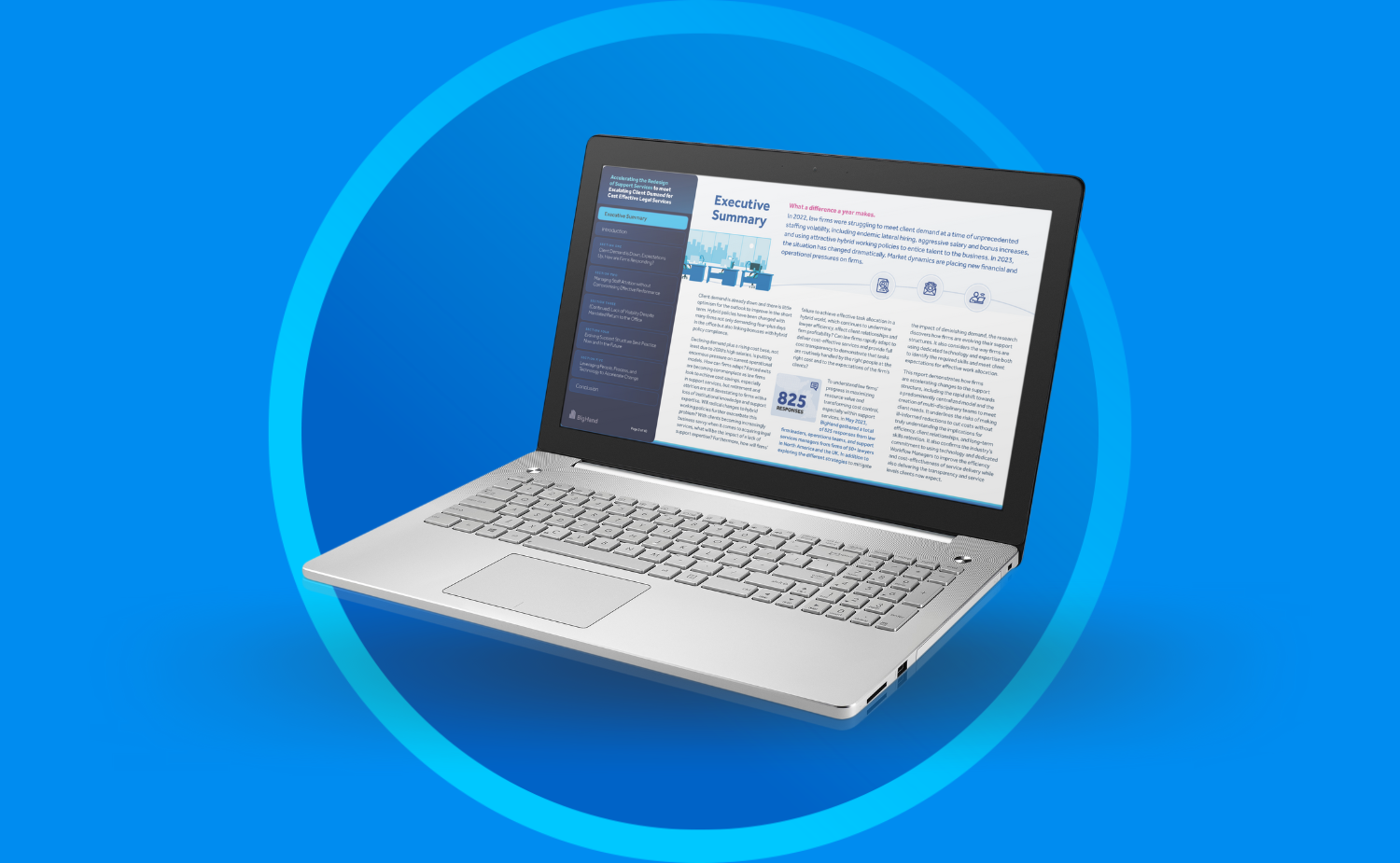- Data on attrition through lateral hiring and retirement
- Forced headcount reductions - what have firms already done and what are they planning
- Costs associated with replacing staff
- Legal client demands on transparency on resourcing.

Read on desktop, mobile, or take it offline!
The legal market is experiencing a serious reversal of fortune. Client demand is down and the decline is expected to continue, compelling firms to take decisive action to safeguard profit. After years of growth, however, what is the best approach to manage the downturn? While there is a pressing need to respond fast to an increasingly negative demand outlook, the wrong strategy could be very damaging to the firm.
A decision to increase prices is understandable given the escalating cost base experienced over the past year or so, but when law firms have been experiencing increasing client calls for more cost-effective service delivery for years, is a price hike tenable in a highly competitive market? Would it be better to cut rates and opt for lower profits as a short-term solution aimed at growth? Although lateral hiring is still widespread, firms have valid concerns regarding the risk of a further talent exodus.
Cost cutting is firmly on the agenda with many firms and with increasing pressure on staff costs, including the huge recruitment fees incurred during the last couple of years, what are the options for improving efficiency and reducing support staff overhead? Critically, can this be achieved without compromising service to the lawyers, and ultimately the firm's clients? And, if so, how?
 Following a strong 2021 and steady performance during early 2022, the tide has now turned; 75% of respondents confirm they have experienced a drop in demand for legal services over the past 12 months. This reduction is not expected to be short-lived, with Thomson Reuters predicting tough times ahead for the legal industry. As a result, most firms that have experienced a drop in demand have made changes over the past few months to mitigate the bottom-line impact.
Following a strong 2021 and steady performance during early 2022, the tide has now turned; 75% of respondents confirm they have experienced a drop in demand for legal services over the past 12 months. This reduction is not expected to be short-lived, with Thomson Reuters predicting tough times ahead for the legal industry. As a result, most firms that have experienced a drop in demand have made changes over the past few months to mitigate the bottom-line impact.
The response to this crisis is not consistent, however. Not only are law firms adopting diverse strategies but, in some cases, their plans appear contradictory, demonstrating a widespread lack of consensus about how to address this new market dynamic.
Almost a third (30%) of firms confirm they have taken the potentially risky move to increase prices as a direct response to the decline in demand (and on top of their planned price rises). Yet when clients are also facing the economic downturn and, as a result, asking for further pricing transparency and visibility, is there any tolerance for a pricing hike? Indeed, 61% of firms have opted to reduce prices in response to client pressure when buying legal work over the past 12 months suggesting that a price-sensitive client base could potentially leave for a lower-cost alternative if costs continue to rise.
As expected in a market with reduced demand, firms are prioritizing cost reduction but, considering the escalating costs experienced in recent years, making cuts is far from straightforward, especially with an increasingly business-savvy client base. Talent is both a law firm’s biggest cost and biggest asset – the wrong decisions can become commercially damaging very quickly.
Given the hemorrhage of employees to lateral hiring that has occurred in recent years, with major law firms making 1,765 more lateral associate hires over entry-level hires, it is interesting that almost a quarter of firms (22%) have opted to accept lower profit levels, while 29% have changed benefits packages, including base salaries.
This strategy could backfire if staff opt to move to firms that have retained their salary levels. Losing skilled associates is very costly, not only due to the extent to which associate salaries have soared in recent years, but partners often spend many hours on recruiting efforts rather than client-focused work. In addition, the time spent developing these associates is now to the benefit of the firm they migrate to. How confident are firms that the additional hiring costs will not wipe out the benefits they are aiming to achieve through accepting lower profits and reducing salary/benefit packages?
 Firms are, however, clearly expecting the recent high levels of attrition to tail off, with 20% making reductions across fee-earning employees. Furthermore, over a quarter (26%) of firms - and notably 29% of firms in North America - have made headcount reductions among non-fee-earning employees. While reducing the number of support staff delivers immediate cost savings, the trend also raises questions about how firms will ensure the right tasks are undertaken by staff with the correct level of expertise. How will firms avoid the inevitable write-offs associated with lawyers undertaking administrative work – a cost that price-sensitive clients will not accept?
Firms are, however, clearly expecting the recent high levels of attrition to tail off, with 20% making reductions across fee-earning employees. Furthermore, over a quarter (26%) of firms - and notably 29% of firms in North America - have made headcount reductions among non-fee-earning employees. While reducing the number of support staff delivers immediate cost savings, the trend also raises questions about how firms will ensure the right tasks are undertaken by staff with the correct level of expertise. How will firms avoid the inevitable write-offs associated with lawyers undertaking administrative work – a cost that price-sensitive clients will not accept?
Rather than increase prices, 29% of firms are focusing on building stronger client relationships to address the downturn in demand. The value of close, trusted relationships, at both a firm and an individual lawyer level, is widely recognized by in-house legal teams, with a trend towards clients looking for a single, global law firm with access to broad, multi-disciplinary teams to support all of their service needs.
Indeed, the time it takes to build new relationships is a notable additional cost for every business. There is a growing recognition that face-to-face interactions are still very important to both building and reinforcing the quality and depth of a relationship. However, with 21% of firms reducing travel, expenses, and rental spend, will senior lawyers have access to the resources required to engage in relationship-building activity with clients?
 This is especially key given the changes in client expectations. The vast majority (87%) of firms confirm that clients have become far more cost-conscious when buying legal services over the past 12 months. The impact of this change in attitude is that clients are demanding even more visibility of work, who did it, and at what cost throughout the lifecycle of an engagement. In addition to visibility, firms want proof that work is being achieved cost-effectively. With 74% of firms reporting pressure from clients for legal work to be completed by the most cost-effective resource, there is a growing risk that clients will challenge bills that either don’t provide that level of insight or show that work is undertaken by the wrong resource.
This is especially key given the changes in client expectations. The vast majority (87%) of firms confirm that clients have become far more cost-conscious when buying legal services over the past 12 months. The impact of this change in attitude is that clients are demanding even more visibility of work, who did it, and at what cost throughout the lifecycle of an engagement. In addition to visibility, firms want proof that work is being achieved cost-effectively. With 74% of firms reporting pressure from clients for legal work to be completed by the most cost-effective resource, there is a growing risk that clients will challenge bills that either don’t provide that level of insight or show that work is undertaken by the wrong resource.
If firms aren't using the right resources for the lower-level tasks – even worse, if lawyers are undertaking administrative tasks – that time will not be recoverable, unless the firm is willing to risk compromising the client relationship. Essentially, without visibility and control over work allocation firms either face writing off the time of their most expensive asset, their lawyers, or undermining client relationships during a period of reduced demand. Either approach risks a serious bottom-line impact. In contrast, those firms able to both allocate work effectively and demonstrate this to clients will be well placed to win new business and build stronger client relationships.
There is a strong drive to embed efficiency throughout the firm by using technology to improve workflow and surface vital information to support every aspect of the client relationship. Over a quarter (26%) of firms have already implemented technology specifically to drive efficiency and profit. Notably, almost two-thirds (63%) are actively highlighting the use of this technology to their clients and potential clients to demonstrate how they are operating efficiently and cost-effectively. Technology is not just an enabler of a more efficient firm but an opportunity to promote competitive differentiation.
 This investment in technology is enabling firms to significantly improve many aspects of both internal processes and client engagement. Well over half (58%) of firms have improved their model for business pitching, with the creation of more detailed/professional pitches designed to meet client expectations for far more information sharing throughout a relationship.
This investment in technology is enabling firms to significantly improve many aspects of both internal processes and client engagement. Well over half (58%) of firms have improved their model for business pitching, with the creation of more detailed/professional pitches designed to meet client expectations for far more information sharing throughout a relationship.
Almost two-thirds (64%) are now focusing heavily on ensuring the right work is allocated to the right people, with 59% looking to find operational efficiencies through better utilization of staff and expertise.  This step change in productivity and performance can only be achieved if a law firm has the information available to understand demand and the workflow to ensure seamless, efficient, and timely work allocation. Investments in technology have played a significant role in enabling these changes, with 62% of firms indicating they now have better financial transparency, while 63% have better visibility of who is working on a matter.
This step change in productivity and performance can only be achieved if a law firm has the information available to understand demand and the workflow to ensure seamless, efficient, and timely work allocation. Investments in technology have played a significant role in enabling these changes, with 62% of firms indicating they now have better financial transparency, while 63% have better visibility of who is working on a matter.
 This research confirms that law firms are not optimistic about the market outlook: three quarters (75%) believe client demand will continue to decline in the next 12 months. The pressure is on to ensure existing clients are retained and minimize the inefficiencies in work allocation that can lead to profit-damaging write-offs. The trend for clients looking for greater value in legal services – and demanding visibility and transparency to prove that value – is not new. BigHand has been tracking the growing expectations from clients for work to be allocated to the right resource at the right cost for some years and exploring how best to safeguard profitability. The current financial outlook is clearly accelerating this trend, however, and creating a new imperative for law firms to embrace long-term, sustainable strategies to improve productivity and reduce costs while also seeking and growing deeper client engagements.
This research confirms that law firms are not optimistic about the market outlook: three quarters (75%) believe client demand will continue to decline in the next 12 months. The pressure is on to ensure existing clients are retained and minimize the inefficiencies in work allocation that can lead to profit-damaging write-offs. The trend for clients looking for greater value in legal services – and demanding visibility and transparency to prove that value – is not new. BigHand has been tracking the growing expectations from clients for work to be allocated to the right resource at the right cost for some years and exploring how best to safeguard profitability. The current financial outlook is clearly accelerating this trend, however, and creating a new imperative for law firms to embrace long-term, sustainable strategies to improve productivity and reduce costs while also seeking and growing deeper client engagements.
Cutting costs is an obvious move in a declining market, but as this research confirms, there are risks involved. If cost reduction is to be a long-term strategy for success, it must be supported by better processes and greater efficiencies. With the right model, firms can both reduce outgoing costs and deliver the transparency of cost-effective service delivery that will be key to both winning and retaining profitable client business.